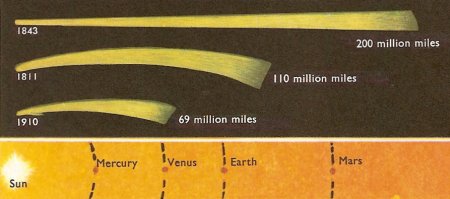Great Comets

The lengths of the great comets of 1811 and 1843, and that of Halley's Comet in 1910 compared with the size of the planetary orbits.
Great Comets are long-period comets of the past couple of centuries that achieved unusual brilliance in the nighttime (and, in some cases, even the daytime) sky.
The Great Comet of 1811 reached peak brightness during September and October and could be seen with the unaided eye for 9 months – the longest period of comet naked-eye visibility on record. It was referred to by Leo Tolstoy in his War and Peace and was popularly associated with the turmoil of this period.
The Great March Comet of 1843 was first noticed in late February and, when at its greatest brilliance – visible only from southern latitudes for a few hours on 28 February – it outshone any comet seen in the previous seven centuries. The tail of the comet holds the record for actual length: an estimated 300 million kilometers.
The Great September Comet of 1882 (C/1882 R1) was discovered a few days before reaching perihelion and grew 10 times brighter each day as it plunged toward the Sun. On 16 and 17 September, it was an impressive naked-eye object next to the midday Sun.


